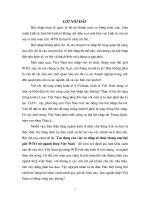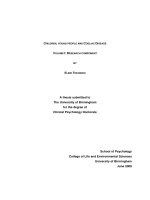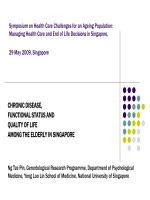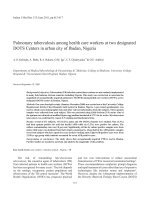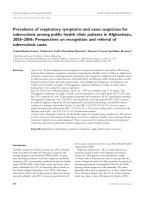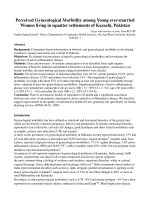High Degree of Adherence to Statin Therapy Among the Elderly Despite High Frequency of Side Effects doc
Bạn đang xem bản rút gọn của tài liệu. Xem và tải ngay bản đầy đủ của tài liệu tại đây (492.68 KB, 7 trang )
Healthy Aging & Clinical Care in the Elderly 2011:3 1–7
doi: 10.4137/HACCE.S7149
This article is available from .
© the author(s), publisher and licensee Libertas Academica Ltd.
This is an open access article. Unrestricted non-commercial use is permitted provided the original work is properly cited.
OPEN ACCESS
Full open access to this and
thousands of other papers at
.
Healthy Aging & Clinical Care in the Elderly
ORIGINAL RESEARCH
Healthy Aging & Clinical Care in the Elderly 2011:3 1
High Degree of Adherence to Statin Therapy Among
the Elderly Despite High Frequency of Side Effects
Fadi Chedid
1
and Magnus Falk
2,3
1
Ljungsbro Primary Health Care Centre, County of Östergötland, 581 85 Linköping, Sweden.
2
Research and
Development Unit for Local Health Care, County of Östergötland, 581 85 Linköping, Sweden.
3
Department of Medical
and Health Sciences, Division of Community Medicine, Primary Care, Linköping University, 581 85 Linköping, Sweden.
Corresponding author email:
Abstract: The aims of the present study were to investigate adherence and side effects of statin therapy in elderly patients ($75 years)
after primary statin prescription, to identify possible differences related to whether statin treatment was initiated in primary care or in
hospital, and to investigate whether there was any correlation between side effects of statin therapy and statin dose or renal impairment.
In two primary health care populations, all patients $75 years of age recently initiated on statin therapy were identied through the
patient data records (n = 90) and asked to complete a questionnaire. Of 68 subjects responding to the questionnaire, 87% reported adher-
ence to the statin therapy and 29% reported side effects. No statistically signicant difference was seen for adherence or frequency of
side effects depending on whether therapy was initiated in primary care or in hospital. In conclusion, elderly patients appear to exhibit
a high degree of adherence to statin treatment despite a high incidence of side effects.
Keywords: statins, elderly, polypharmacy, adherence
Chedid and Falk
2 Healthy Aging & Clinical Care in the Elderly 2011:3
Introduction
Statins are the most important and most well-
documented group of lipid-lowering drugs. Statin ther-
apy has been shown to reduce cardiovascular morbidity
and mortality in several meta-analysis studies.
1–3
The
morbidity of these diseases increases with age, there-
fore the age at initiation of statin therapy also tends to
increase. Reduced mortality by secondary prevention
has been demonstrated for coronary heart disease in
all age groups, even in individuals more than 80 years
of age.
4
However, data on morbidity and mortality by
primary prevention is insufcient in elderly people
more than 75 years of age. Therapy recommendations
and guidelines are based on the individual’s estimated
total risk of developing cardiovascular disease.
5
In Sweden, simvastatin is recommended by all
regional drug committees as the primary choice
statin.
6
Eighty-three percent of all patients treated
with statins in Sweden are prescribed simvastatin.
Switch of therapy to another statin is mainly on the
basis of side effects, or if the intended target value
of blood lipids cannot be reached. The other statins
marketed in Sweden, representing the remaining 17%
of the market share, are atorvastatin, rosuvastatin,
pravastatin, and uvastatin. Of these, atorvastatin is
the most common (14%); the other 3 are only used by
3% of those treated with statins.
6
Statins act by inhibiting the enzyme HMG-
CoA reductase (3-hydroxy-3-methylglutaryl-CoA
reductase) which regulates cholesterol synthesis.
Treatment with statins is generally safe, with few
side effects. The most clinically important side effect
is myopathy, dened as muscle pain, tenderness or
weakness. In clinical trials, a tenfold increase in serum
creatine kinase (CK) is also included as a side effect.
5,7,8
Occasionally myopathy can develop into rhabdomyol-
ysis (muscle breakdown), resulting in myoglobinuria
(excretion of myoglobin in the urine), and acute renal
failure. In very rare cases, a fatal outcome may occur.
9
The risk for myopathy is increased by high levels of
HMG-CoA reductase inhibitory activity in plasma.
In a database derived from clinical trials, myopathy
incidences of 0.02%, 0.08%, and 0.53% for simvasta-
tin doses of 20, 40, and 80 mg/day, respectively, have
been described. The patients in these trials were care-
fully monitored, and certain interacting drugs were
excluded.
7,8
Other listed side effects of simvastatin
were gastrointestinal (constipation, abdominal pain,
diarrhea, nausea, and vomiting), neurological (head-
ache, paresthesia, and dizziness), and dermatological
(pruritus, rash, and hair loss). All side effects have
been classied as rare ($1/10,000, ,1/1000).
9
Renal function, expressed as a glomerular ltration
rate (GFR), declines with increasing age. At the age of
75 years, the GFR has declined by 50% on average.
10
It is recommended that in patients with severe renal
insufciency (creatinine clearance ,30 mL/min),
simvastatin doses exceeding 10 mg/day should be
considered carefully, and if necessary, implemented
cautiously. In the current regional guidelines for
lipid-lowering therapy in south eastern Sweden,
where the present study was performed, no reserva-
tions for impaired renal function are mentioned. The
recommendation is to initiate 40 mg simvastatin as
the starting and target dose “to all patients for whom
treatment indication exists”.
11
Furthermore, the impor-
tance of target values (varying according to patients’
different risks of developing cardiovascular disease,
eg, total cholesterol ,4–5 mmol/L, and low-density
lipoprotein (LDL) ,2–3 mmol/L), as well as strate-
gies to achieve them, are highlighted. However, stud-
ies conducted solely on the basis of the proposed target
values are lacking. Most existing statin trials have
examined xed doses of statins (placebo versus sta-
tins, or low dose versus high dose of statins) and, as a
consequence, the current blood lipid target values are
based on indirect conclusions on the effect of different
statin doses related to morbidity and mortality.
12
Surveys of drug utilization among the elderly
reveal that .90% of persons aged 75 years or older
use medications regularly. Elderly people living in
private homes are prescribed an average of 5 medica-
tions, and those living in special housing are prescribed
an average of 10 medications.
13,14
This polypharmacy
entails a risk for interactions and unwanted side
effects.
15
Adherence levels vary, but some studies
have shown a 66%–75% adherence to drug treatment
for cardiovascular diseases.
16,17
However, considering
all aspects of compliance, such as the incorrect use
of prescribed drugs at home, the estimated adherence
has been reported to be less than 50%.
18
The dose–response curve for statins reveals that
doubling the dose only results in 6% additional
decrease in LDL.
19
The benet of lowering LDL cho-
lesterol with a high dose of simvastatin was recently
investigated in a multicenter study involving 12,064
Adherence to statin therapy among the elderly
Healthy Aging & Clinical Care in the Elderly 2011:3 3
patients with a history of myocardial infarction.
20
One
group was randomly assigned to 20 mg and a second
group to 80 mg simvastatin. At a mean follow-up of
6.7 years, the results showed that LDL was on aver-
age 0.35 mmol/L lower in the high dose group, but no
statistically signicant difference was seen in terms
of primary end points (major cardiovascular events,
stroke, and revascularization) between the groups.
However, there was an overall difference in adverse
events, with 53 (0.9%) patients affected by myopathy
in the high dose group and only 2 (0.03%) in the low-
dose group.
20
Side effects may thus constitute a barrier to suc-
cessful drug treatment. Because statins are an impor-
tant element in the treatment of cardiovascular disease,
it is crucial to create good conditions for patients to
adhere to the treatment and to receive the full benets
of statin therapy.
The aims of the present study were:
• to investigate adherence and side effects of statin
therapy in elderly patients ($75 years) after pri-
mary statin prescription
• to identify possible differences related to whether
statin treatment was initiated in primary care (PC)
or in hospital (HC), and
• to investigate whether there was any correlation
between the side effects of statin therapy and statin
dose or renal impairment.
Materials and Methods
The study population was based on patients listed at
2 primary health care centers in Linköping, Sweden.
The population was identied by searching the patient
data records in 2 settings (BMS arkiv, Vårdöversikt
DRIFT 1.0.0.9 and Cambio COSMIC, 1.1.0.4). All
patients $75 years who had been initiated on sim-
vastatin or atorvastatin treatment between January
1, 2006 and December 31, 2008 (inclusion criteria)
were recruited. Prescribed treatment that, for some
reason, was never initialized, was the only exclusion
criterion. The subjects were divided into 2 groups:
one group for which statins were prescribed in PC
and a second group prescribed in HC. The HC group
included both outpatient and inpatient care given in
hospitals.
A questionnaire on adherence and side effects of
statin treatment was sent to all patients in both groups.
A written letter with information about the study was
sent with the questionnaire. After 4 weeks, a reminder
was sent to the patients who had not responded to the
rst request. Patients who were willing to participate
gave written informed consent.
In the present study, adherence was dened as a
positive answer to the question on whether the sub-
jects were taking simvastatin or atorvastatin as pre-
scribed by their doctor. For those patients who reported
adherence to the treatment, further verication was
performed by searching patient data records to see if
they had received a renewed prescription during the
last 12 months following initial prescription, indicat-
ing that the treatment had continued.
Renal function was dened as the estimated
GFR and was obtained using the Cockcroft–Gault
formula:
Men $20 years: GFR = (1.23 × (140 - age) × weight)/
serum creatinine
Women $20 years: GFR = (1.04 × (140 - age) × weight)/
serum creatinine
Creatinine values were obtained from the labora-
tory modules in the patient data records. If creatinine
levels were not recorded within the last 6 months,
subjects were requested by letter to undergo a new
creatinine blood test.
Statistical analysis
Data from the questionnaire were analyzed using
SPSS Statistics 17.0 software. Pearson’s χ
2
test was
performed to determine possible differences between
primary and hospital care concerning compliance,
side effects, statin dose, and renal function. Whether
the level of side effects was related to compliance,
statin dose, or renal function was also investigated.
A signicance level of P , 0.05 was chosen.
Ethics approval
The study was reviewed and approved by the Regional
Ethical Review Board in Linköping, Sweden (No.
M204-09).
Results
A total of 90 individuals fullling the inclusion crite-
ria were identied. Simvastatin was the drug used pri-
marily for all patients (PC 51, HC 39). Response were
received from 70 subjects (PC 37, HC 33), giving
Chedid and Falk
4 Healthy Aging & Clinical Care in the Elderly 2011:3
an overall response rate of 78%. Two patients were
excluded from the study, because their prescribed
treatment was never initialized. Three patients were
deceased and 17 did not answer. The demographic
characteristics of the 2 groups were similar (Table 1).
Adherence
Fifty-nine of the 68 subjects reported that they had fol-
lowed the doctor’s prescription, which corresponds to
87% adherence. No signicant difference was noted
between the 2 groups (PC 83%, HC 91%). For fur-
ther verication of the adherence level, the patients’
data records were examined. It was found that 95%
of subjects reporting adherence to the statin ther-
apy had received a renewed prescription during the
last 12 months. Of the 9 subjects who reported that
they did not follow the prescription, 5 declared side
effects as the reason. Of these, 2 were received ator-
vastatin instead with good tolerance. The remaining 4
(PC 3; HC 1) reported that they had initiated lifestyle
changes and therefore did not consider themselves to
be in need of statin treatment.
Side effects
The occurrence of side effects was reported by 20
patients (29%). No signicant difference was found
depending on where the treatment was initiated (PC
25%, HC 34%). The proportions of side effects were
similar for neurological, dermatological and muscle-
related symptoms. In contrast, gastrointestinal side
effects were more uncommon. Regarding only muscu-
lar symptoms as side effects, the overall rate was 15%.
Adherence related to side effect frequency
Adherence was higher (92%) among the patients who
reported no side effects from their medication com-
pared with those with side effects (75%). However, the
difference was not statistically signicant (P = 0.065)
(Fig. 1).
Statin dose
Simvastatin was prescribed in doses of 10, 20, or
40 mg/day. The distribution of the doses differed
signicantly between hospital and primary care. In
the hospital group, 81% of patients received high
dose simvastatin (40 mg); the corresponding propor-
tion in the primary care group was 36% (P , 0.001)
(Fig. 2). The proportion of reported side effects was
similar for the higher dose (40 mg) and the lower dose
(#20 mg) simvastatin (28% and 31%, respectively).
Renal function
Renal impairment, dened as estimated GFR
, 60 mL/min, was present in 65% of the subjects. In
the upper age interval (ie, higher than the mean age
of 82 years), renal impairment was noted in as many
as 82% of the subjects. There was no signicant dif-
ference in renal function between patients in the PC
group (61%) and the HC group (69%). Subjects with
impaired renal function reported equal frequency of
side effects as those with normal renal function (30%
and 29%, respectively).
Discussion
In the present study, we examined the adherence
and side effects of statin treatment in a population of
elderly patients ($75 years) who initiated the treatment
between January 2006 and December 2008), using
a questionnaire sent out in January/ February 2010.
Table 1. Characteristics of subjects subdivided according
to whether statin treatment was initiated in primary care
(PC) or in hospital (HC).
PC
(n = 36)
HC
(n = 32)
Total
(n = 68)
Male (individuals) 15 15 30
Female (individuals) 21 17 38
Mean body weight (kg) 73 72 73
Mean age (years) 82 82 82
Median age (years) 81 82 81
75%
92%
25%
0%
50%
75%
100%
No side effectsSide effects
Adherence
Figure 1. Adherence among subjects who reported the presence of
side effects (n = 20) compared with those who reported no side effects
(n = 48) (P = 0.065).
Adherence to statin therapy among the elderly
Healthy Aging & Clinical Care in the Elderly 2011:3 5
Thus, the patients were on the treatment for at least
a year when the survey was conducted. The study
focused on the two statins (simvastatin and atorvas-
tatin) most commonly used in Sweden. In all cases
in this study, however, simvastatin was the primary
medication at the beginning of treatment and shows
excellent adherence to existing guidelines.
A surprisingly high proportion of patients (87%)
claimed to be taking their medicine in accordance with
how their prescription was intended. Previous studies
have suggested a markedly lower adherence to sta-
tin treatment (66%–75%), but these studies report the
average of all age groups.
16,17
This may suggest that
patients $75 years in general have a higher adher-
ence to statin treatment than the average population
on statin treatment. The high adherence level in this
study was conrmed by the fact that 95% of patients
who reported adherence to treatment had received a
new prescription during the last 12 months. However,
adherence is difcult to measure and there is no uni-
versal denition of the term. Depending on which
aspects of adherence are being studied, the outcome
may vary. There are disadvantages to all methods. In
the present study, for example, it was not possible to
display the frequency of renewal of prescriptions for
nonresponders, and it is likely that adherence among
this group is lower.
The overall incidence of side effects was high;
nearly 3 out of 10 patients reported side effects of
treatment. In the larger clinical trials on statins, no
specic differences in the frequency of side effects
between study samples and control groups have been
reported.
7,8
The frequency of myopathy in combina-
tion with a tenfold rise in CK levels has been reported
to be 0.02%–0.08%.
9
In the present study, measure-
ment of CK was not included, thus it is not possi-
ble to fully relate to these numbers. The frequency
of muscle-related symptoms without an associ-
ated increase in CK was more than twice as high
(15%) in the present study compared with previous
studies (6%).
7,8
This may indicate that elderly patients
are more likely to develop myopathy from statin
therapy. However, because there was no control group
for comparison (a weakness of the study) conclusions
must be drawn with caution. Many elderly patients
utilize multiple drugs, and it is difcult for them to
decide which drug is causing side effects. However,
irrespective of cause, these side effects are still a real-
ity for the patient. Therefore, it is important for health
care providers to be observant and receptive of reports
on possible adverse drug reactions from the patients,
in order to reconsider the medication if necessary.
When comparing patients prescribed statins in
PC and HC, no signicant difference in adherence or
side effect rates could be demonstrated between the
2 groups. In the total patient population in the study,
lower adherence was seen in the group of subjects who
reported side effects (75%) compared with those who
experienced no side effects (92%), but this difference
did not reach statistical signicance (P = 0.065). This
may possibly reect the limited size of the popula-
tion, which is the main weakness of the study.
The study shows that hospital clinicians prescribe
higher doses of simvastatin to a much greater extent
than primary health care physicians. This might be
explained by the fact that statin treatment initiated
in primary care is often done for primary prevention
purposes, and that the acceptance of side effects in
that situation is lower. In the present study, however,
no dose relationship with side effects was observed.
The frequency of side effect was similar in the group
treated with low-dose simvastatin compared with
patients receiving higher doses. Thus, these data
would support the recommendation to begin treat-
ment by prescribing 40 mg of simvastatin. However,
the population in this study is too small to reliably
draw such conclusions. Moreover, it is not deter-
mined whether a higher dose of simvastatin results in
increased benets, especially when parts of the results
of the extensive SEARCH study (Study of the Effec-
tiveness of Additional Reductions in Cholesterol and
Homocysteine) are considered. There was no signi-
cant reduction in primary end points after treatment
with 80 mg simvastatin compared with 20 mg, but the
frequency of side effects was much higher.
20
36%
81%
56%
19%
8%
0%
PV HC
25%
50%
75%
100%
10 mg
20 mg
40 mg
Figure 2. Distribution of simvastatin treatment according to whether it
was initiated in primary care (PC) or in hospital (HC).
Chedid and Falk
6 Healthy Aging & Clinical Care in the Elderly 2011:3
An established reference interval for renal
function in the elderly does not exist, but a GFR
$ 60 mL/min is a recommendation. Renal insuf-
ciency (GFR , 60 mL/min) was noted in almost two
thirds of the patients throughout the study population.
There was, however, as expected an age-related skew-
ness in the distribution of renal function impairment,
which reached 82% in the upper age range. A large pro-
portion of elderly people with impaired renal function
has also been conrmed in previous studies.
10
Health
care providers should therefore pay special attention
to renal function in the elderly in the prescription
of drugs with potential renal effects (eg, nonsteroi-
dal antiinammatory drugs, angiotensin-converting
enzyme inhibitors, etc).
There was no association in this study between
renal function and side effects. The frequency of
adverse events was similar in the group with renal
impairment compared with the group with normal
renal function. There might be other parameters that
are central to the occurrence of side effects. In the
dose recommendation for simvastatin it is stated that
a creatinine clearance below 30 mL/min requires dose
adjustment. In the present study there was only one
patient with renal function below this level.
Conclusion
In conclusion, elderly patients appear to exhibit a
high degree of adherence to statin treatment despite
a high incidence of side effects. Simvastatin is used
in higher doses in hospital clinics compared with pri-
mary care, but the incidence of side effects does not
seem to be greater at the higher doses. Almost two
thirds of the older patients in the study had renal dys-
function but no correlation was found between renal
impairment and the frequency of side effects. The
material in this study is relatively limited and it is
possible that the outcome would have been different
in a larger study population. This study would thus
need to be replicated in an extended study in order to
conrm these ndings.
Disclosure
This manuscript has been read and approved by all
authors. This paper is unique and is not under consid-
eration by any other publication and has not been pub-
lished elsewhere. The authors and peer reviewers of
this paper report no conicts of interest. The authors
conrm that they have permission to reproduce any
copyrighted material.
References
1. LaRosa JC, He J, Vupputuri S. Effect of statins on risk of coronary disease:
a meta-analysis of randomized controlled trials. JAMA. 1999;282:2340–6.
2. Wilt TJ, Bloomeld HE, MacDonald R, et al. Effectiveness of statin therapy
in adults with coronary heart disease. Arch Intern Med. 2004;164:1427–36.
3. Brugts JJ, Yetgin T, Hoeks SE, et al. The benets of statins in people with-
out established cardiovascular disease but with cardiovascular risk factors:
meta-analysis of randomised controlled trials. BMJ. 2009;338:b2376.
4. Allen Maycock CA, Muhlestein JB, Horne BD, et al. Statin therapy is asso-
ciated with reduced mortality across all age groups of individuals with sig-
nicant coronary disease, including very elderly patients. J Am Coll Cardiol.
2002;40:1777–85.
5. Ali R, Alexander KP. Statins for the primary prevention of cardiovascular
events in older adults: a review of the evidence. Am J Geriatr Pharmacother.
2007;5:52–63.
6. Hjemdahl P, Allhammar A, Heaton C, et al. SBU should investigate what
is an evidence-based and cost-effective use of statins. Läkartidningen.
2009;32–3:1992–4 (in Swedish).
7. Scandinavian Simvastatin Survival Study Group. Randomised trial of cho-
lesterol lowering in 4444 patients with coronary heart disease: the Scandi-
navian Simvastatin Survival Study (4S). Lancet. 1994;344(8934):1383–9.
8. Heart Protection Study Collaborative Group. MRC/BHF Heart Protec-
tion Study of cholesterol lowering with simvastatin in 20,536 high-
risk individuals: a randomised placebo-controlled trial. Lancet. 2002;
360(9326):7–22.
9. The research-based pharmaceutical industry in Sweden. FASS—The
Swedish medicine information portal on the internet. Available from: http://
www.fass.se. Accessed March 11, 2011.
10. Lindström K, Kindgren L, Zarova T, Frisenette-Fich C. Adverse drug effects
among the elderly can be reduced. Läkartidningen. 2007;4:242–4 (in Swedish).
11. Endocrinology Expert Group, County of Östergötland. Blood lipid
disorders—background and motivation. Updated December. Available from:
mitteer-/Lakemedelskommitten-i-Ostergotland/Rekommenderade-lakeme-
del/Endokrinologi-inklusive-hypertoni/Blodfettsrubbningar—bakgrund-
och-motivering-/. Accessed February 15, 2011.
12. Hayward RA, Hofer TP, Vijan S. Narrative review: lack of evidence for rec-
ommended low-density lipoprotein treatment targets: a solvable problem.
Ann Intern Med. 2006;145:520–30.
13. The Swedish National Board of Health and Welfare. Stockholm: The institute
2004. Monitoring of medication use among elderly. ISBN: 91-7201-930-1.
Available from:
Accessed March 11, 2011.
14. Johnell K, Fastbom J, Rosén M, Leimanis A. Inappropriate drug use in the
elderly: a nationwide register-based study. Ann Pharmacother. 2007;41(7):
1243–8.
15. Fastbom J. Increased consumption of drugs among the elderly results in
greater risk of problems. Läkartidningen. 2001;98:1674–9 (in Swedish).
16. Hagström B, Mattsson B, Rost IM, et al. What happened to the prescriptions?
A single, short, standardized telephone call may increase compliance. Fam
Pract. 2004;21:46–50.
17. Howell N, Trotter R, Mottram DR, et al. Compliance with statins in primary
care. Pharm J. 2004;272:23–6.
18. Ingersoll KS, Cohen J. The impact of medication regimen factors on adherence
to chronic treatment: a review of literature. J Behav Med. 2008;31(3):213–4.
19. Law MR, Wald NJ, Rudnicka AR. Quantifying effect of statins on low den-
sity lipoprotein cholesterol, ischaemic heart disease, and stroke: systematic
review and meta-analysis. BMJ. 2003;326:1423.
20. Study of the Effectiveness of Additional Reductions in Cholesterol and
Homocysteine (SEARCH) Collaborative Group. Intensive lowering of LDL
cholesterol with 80 mg versus 20 mg simvastatin daily in 12 064 survivors
of myocardial infarction: a double-blind randomised trial. Lancet. 2010;376:
1658–69.
Publish with Libertas Academica and
every scientist working in your eld can
read your article
“I would like to say that this is the most author-friendly
editing process I have experienced in over 150
publications. Thank you most sincerely.”
“The communication between your staff and me has
been terric. Whenever progress is made with the
manuscript, I receive notice. Quite honestly, I’ve
never had such complete communication with a
journal.”
“LA is different, and hopefully represents a kind of
scientic publication machinery that removes the
hurdles from free ow of scientic thought.”
Your paper will be:
• Available to your entire community
free of charge
• Fairly and quickly peer reviewed
• Yours! You retain copyright
Adherence to statin therapy among the elderly
Healthy Aging & Clinical Care in the Elderly 2011:3 7
21. Cockcroft DW, Gault MH. Prediction of creatinine clearance from serum
creatinine. Nephron. 1976;16;31–41.
22. Simonsson P. New Swedish recommendations on renal diagnostics. Learn
about your patient’s GFR! Läkartidningen. 2009;7:425–7 (in Swedish).
23. Wasén E, Isoaho R, Mattila K, et al. Estimation of glomerular ltration
rate in the elderly: a comparison of creatinine-based formulae with serum
cystatin C. J Intern Med. 2004;256:70–8.
